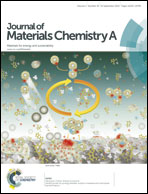Advanced germanium nanoparticle composite anodes using single wall carbon nanotube conductive additives†
Abstract
The morphology, thermal stability, impedance, and rate performance of germanium nanoparticle (Ge-NP) based lithium ion battery electrodes that incorporate single-walled carbon nanotube (SWCNT) conductive additives has been systematically studied for varying SWCNT loadings (1–3% w/w SWCNT) and electrode areal capacities (4–12 mA h cm−2). Scanning electron microscopy (SEM) was used to characterize the surface coverage for carbon black and SWCNT conductive additives. Differential scanning calorimetry (DSC) analysis shows a 30% reduction in exothermic release with SWCNT conductive additives, which demonstrates improved thermal stability for Ge-NP electrodes. Electrochemical impedance spectroscopy (EIS) indicates that the charge transfer impedance can be reduced roughly 2.5× when comparing 5% carbon black to ≤3% SWCNT conductive additive. Electrochemical cycling and rate testing demonstrate that SWCNT conductive additives provide significantly improved specific capacities (1100 mA h g−1 with 1% SWCNT) and rate performance (80% capacity retention at effective 1 C rate) over traditional carbon black conductive additives when using Ge-NP active material. In addition to the benefits for thermal stability, impedance, and rate performance, predicted energy density gains from Ge-NP anodes can be up to 20–25% in full batteries.


 Please wait while we load your content...
Please wait while we load your content...